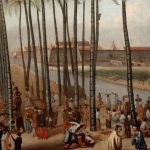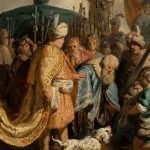The exhibition “Rembrandt’s Orient”, which just closed at Kunstmuseum Basel and will be on view soon at Museum Barberini in Potsdam, examines how the painters of the Dutch Golden Age reacted to the areas of the Near, Middle and Far East that had come into view through trade, travel and publications in the 17th century. Curated by Bodo Brinkmann, Gabriel Dette and Gary Schwartz, the exhibition features works by Rembrandt and his colleagues and students, and also includes publications and other sources that illustrate the contemporary vision of the Orient.
In three short videos the curators Bodo Brinkmann and Gabriel Dette present highlights of the show. In the first video, Dr Bodo Brinkmann (Curator, Old Masters, 15th-18th Centuries at Kunstmuseum Basel) explains what Rembrandt van Rijn’s painting “Musical Company” has to do with Sodom and Gomorrah. (in German with english subtitles).
Rembrandt’s Orient – West Meets East in Dutch Art of the 17th Century at Kunstmuseum Basel | Neubau. Highlights (1/3), February 3, 2021.
–– Right-click (Mac: ctrl-click) this link to download Quicktime video file.
Excerpt from the media release:
Rembrandt Harmensz. van Rijn’s curiosity about all that was foreign and his insatiable collector’s appetite were legendary even in his lifetime. As an artist, collector, and citizen, he came into contact with artifacts, objects of utility, and humans from all parts of the known world and found creative inspiration in them. This autumn and winter, the exhibition Rembrandt’s Orient at the Kunstmuseum Basel | Neubau presents selected works by the Dutch artist and his colleagues to explore their world of ideas.
Turban and rug, sabre and silk gown—objects from distant lands appear in many works by Rembrandt (1606–1669) and his contemporaries. Their art bears witness to the first globalization and shows the influence of foreign cultures in the seventeenth-century Netherlands. The thirst for knowledge, the zest for collecting, and the pride of ownership defined this seminal period in art history, inspiring painters to conceive novel compositions in genres including history painting, portraiture, and the still life. Modern-day beholders searching their works for an acknowledgment of the dark side of this appropriation of the world’s treasures will be disappointed: they do not reflect the power imbalance between cultures or its manifestations including slavery, violence, exploitation, and trade wars.
The exhibition Rembrandt’s Orient, however, intentionally places the focus on the historic forms in which the foreign was visualized. The concepts of Orient and Occident dated back to antiquity, when they served to schematically divide the world into regions. In Rembrandt’s time, “Orient” simply meant the East. What we now call Orientalism, a Eurocentric attitude that implied a claim to authority over the countries of the Middle East and the Arab world, emerged in the nineteenth and twentieth centuries, and its critique informs today’s debate around the term “Orient.” By entitling our exhibition Rembrandt’s Orient. West Meets East in Dutch Art of the Seventeenth Century, we signal its guiding interest in the ideas bound up with the concept at the time.
Research and sources
The exhibition draws on a wide range of recent scholarship and a number of exhibitions that have addressed aspects of the cultural exchange between East and West in the early modern era. Our guest curator Gary Schwartz played a leading role in these efforts. The author of major monographs on Pieter Saenredam (1989), Jheronimus Bosch (2016), and Johannes Vermeer (2017), he has also studied Rembrandt’s life and oeuvre for decades. His book Rembrandt: His Life, His Paintings. A New Biography, published in 1984, shed light on the artist in his world, charted the intellectual climate of the period, and threw the role that his patrons played into relief. The attention to the social and intellectual context was new at the time and has since inspired many other art historians.
A second key source is in fact found in the Kunstmuseum Basel’s own collection: in the painting David Offering the Head of Goliath to King Saul, created in 1627, we have an early and eminent document of Rembrandt’s engagement with the questions that are at the heart of the exhibition. Moreover, our Kupferstichkabinett (Department of Prints and Drawings) has a sizable set of prints of outstanding quality by Rembrandt, considerably enlarged in recent years by the Berne- based collector Dr. h.c. Eberhard W. Kornfeld’s generous donation of altogether 150 prints. More than a dozen of these works on paper are on display in Rembrandt’s Orient. A concurrent presentation mounted by Ariane Mensger in the Hauptbau’s mezzanine gallery will offer our visitors an opportunity to examine additional pieces from this extraordinarily valuable collection.
Amsterdam and the trading companies
For someone who, for all we know, never left his native country, Rembrandt had a strikingly broad horizon. Amsterdam, the center of his life, was the perfect place for a man of such boundless interests: the Dutch East and West India Companies, which controlled the overseas trade with Asia, Africa, and America and held large colonies there, had their headquarters and home port in the city. Other trading partnerships that plied the routes to Russia, the shores of the Baltic Sea, the Mediterranean, and the Levant helped make seventeenth-century Amsterdam one of Europe’s most important cultural melting pots. Ambassadors, legates, and merchants from far-flung places visited the Dutch Republic and could be seen in the city’s streets. All this colorful bustle fired up the creativity of the numerous local artists, and perhaps none more than Rembrandt.
Rembrandt’s Orient singles out one of the most fruitful and consequential aspects of this specific constellation of interactions between different cultures and the impulses its generated. The Orient— an umbrella term for diverse non-European cultures of the East rather than a well- defined geographic designation—fueled Rembrandt’s imagination throughout his artistic career. The Orient was much more to him than just one source of visual motifs among many; it not only inspired him as he envisioned the settings of biblical histories, one of his favorite genres. Several self-portraits show the artist in exotic costumes. His copies of miniatures created at the court of the Great Mughals were a tribute to Asian creativity and taste without precedent in Dutch art. Last but not least, he was an eager consumer of Japanese paper, on which he liked to print his etchings.
Yet the selection of exhibits is not limited to Rembrandt’s oeuvre. In addition to works by his peers and students, the presentation includes publications and other sources that illustrate the contemporary vision of the Orient. Placing Rembrandt’s work in this broader context reveals both the ways in which his take on the East was typical of his time and what set his perspective on its cultures apart from those of his contemporaries.
One central concern of Rembrandt’s Orient is to examine the different ways in which the artists of the Dutch Golden Age responded to non-European cultures and their artistic products. As one might expect, some of them adopted selected elements, transferring them into familiar models and assimilating the exotic inspirations to their own preexisting ideas of value. Once imported novelties had been integrated into the local culture in this manner, they became commodities—a pattern in intercultural exchange that we can still observe today. On the other hand, some Dutch artists felt genuine admiration for foreign customs and practices and cherished examples of Eastern art. The exhibition vividly illustrates salient cultural-historical aspects of this major chapter in world history with works of art of the highest quality and fascinating books and documents.
The presentation features altogether just over 120 artifacts, including paintings as well as numerous prints, drawings, miniatures, maps, and books. Ca. 100 of them will be in Basel on loan from eminent museum and private collections all over the world such as the Rijksmuseum, Amsterdam; the Hermitage Museum, Saint Petersburg; the National Gallery, the British Museum, and the Victoria and Albert Museum, London; the National Gallery, Washington, D.C.; the Museo Nacional del Prado and the Museo Nacional Thyssen-Bornemisza, Madrid; the Kunsthistorisches Museum, the Albertina, and the Gemäldegalerie of the Academy of Fine Arts, Vienna; the J. Paul Getty Museum, Los Angeles; the Bayerische Staatsgemäldesammlungen, Munich; the Emil Bührle Collection, Zurich; and the Kunstmuseum Winterthur.





